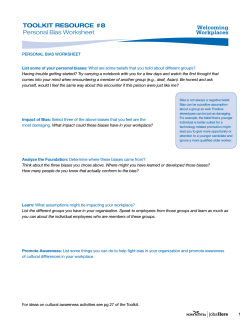
Math 116A - Section 4.2 - Good and Poor Ways to Sample
Math 116A - Section 4.2 - Good and Poor Ways to Sample Name___________________________________ Provide an appropriate response. 1) The manager of a natural foods grocery is considering the addition of a play area and would like to know what percentage of its customers shop with children under the age of 8. To obtain an estimate of this percentage, one morning between 9:00 and 11:00 the cashiers record how many of their customers have children under the age of 8 with them. What type of sample does this represent? A) A simple random sample B) A convenience sample C) A census D) A volunteer sample 2) After a hurricane, a disaster area is divided into 200 equal grids. Thirty of the grids are selected and every occupied household in the grid is interviewed to help focus relief efforts. Select the numbers of the first five grids that belong to the sample using the random numbers given below. 16348 76938 90169 51392 55887 71015 09209 79157 A) 16, 38, 48, 76, 93 B) 16348, 76938, 90169, 51392, 55887 C) 163, 169, 15, 92, 97 D) 890, 169, 539, 255, 887 E) 163, 487,693, 890, 169 3) A magazine publisher inserts a postage-paid survey into an issue of its magazine in order to collect information regarding reader satisfaction with the magazine. What type of sample is this? A) convenience sample B) volunteer sample C) observational sample D) simple random sample Answer true or false. 4) Random selection, letting chance determine which subjects are in the sample, is the key to getting a good sample. A) True B) False 5) Sampling bias occurs when some sampled subjects cannot be reached or refuse to participate or fail to answer some questions. A) False B) True 6) Nonresponse bias occurs when the subject gives an incorrect response. A) True B) False 7) As long as the sample size is large, the sample will be unbiased no matter how it was selected. A) True B) False Identify the bias. 8) Inside the boxes of a new brand of cereal is a short survey that can be mailed back for free to the manufacturer. The survey asks the consumer if he or she likes the cereal or not. What, if any, will be the most noticeable bias for this survey? A) Both nonresponse bias and response bias B) Response bias C) No perceivable bias D) Sampling bias E) Nonresponse bias 1 Provide an appropriate response. 9) Ideally, the sample frame includes A) a convenience sample B) the entire population of interest C) a simple random sample D) none of these E) the entire sample Identify the bias. 10) A magazine publisher mails a survey to every subscriber asking about the quality of its subscription service. From which of the following is this study most likely to suffer? A) Both nonresponse bias and undercoverage B) Both undercoverage and sampling bias C) Undercoverage D) Nonresponse bias E) Sampling bias 11) A bottling company would like to estimate the proportion of its daily production (5000 cases) that meets the appropriate filling guidelines. To do so, the last 5 cases filled in the day are chosen and all of the bottles within these corresponding 5 cases are checked against the guidelines. From which, if any, of the following is this sample likely to suffer? A) Too small of a sample B) Sampling bias C) Nonresponse bias D) No perceivable bias 12) A bottling company would like to estimate the proportion of its daily production (5000 cases) that meets the appropriate filling guidelines. To do so, 5 numbers between 1 and 5000 are randomly chosen and all of the bottles within these corresponding 5 cases are checked against the guidelines. From which, if any, of the following is this sample likely to suffer? A) No perceivable bias B) Non-randomness C) Undercoverage D) Sampling bias Provide an appropriate response. 13) Describe how to use random numbers to select a simple random sample? Select the most appropriate answer. 14) The most common type of convenience sample is A) a systematic sample. B) a volunteer sample. C) a stratified sample. D) a cluster sample. E) a simple random sample. 2
© Copyright 2025














